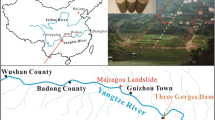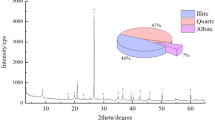Abstract
The mudstone has low bearing capacity and low per Zelin meability, which experiences large deformation and long-term creep. To investigate the creep characteristics of the Tianshui Landslide, Gansu Province, China, triaxial creep tests were conducted. It is shown that the creep behavior of mudstone became more pronounced as the confining pressure, water content, and shear stress level increased. The long-term strength of the mudstone decreased as the creep time increased. A new creep model for the mudstone is proposed. The values predicted by the new model are in good agreement with the test results. The axial strain in the mudstone samples exhibited a linear relationship with time in a log–log graph under different stress states; the strain increased slowly with time and gradually stabilized. The model reflects the residual creep characteristics of the mudstone and can reflect both axial and volumetric creep. Moreover, the microscopic mechanism of clay creep was studied by analysis of scanning electron microscope images. This study considered the actual engineering situation, and the experiment was designed to study steady creep of mudstone under low confining pressure and variable water contents, with the aim of establishing a stable creep model to characterize the mudstone under low confining pressure. The stress–strain–time model of creep deformation of mudstone established herein has few parameters and a simple derivation process and provides new information for evaluating slope long-term stability. The model will be useful for the prediction of mudstone landslides in the Tianshui area.


















Similar content being viewed by others
References
Adaehi T, Oka F, Koike M (2005) An elasto-viscoplastic constitutive model withstrain-softening for soft sedimentary rocks. Soils Found 45(2):125–133
Al-Rawas AA, McGown A (1999) Structure of Omani expansive soils. Can Geotech J 36:272–290
Augustesen A, Liingaard M, Lade PV (2004) Evaluation of time-dependent behavior of soils. Int J Geomech 4(3):137–156
Bozzano F, Martino S, Montagna A (2012) A back analysis of a rock landslide to infer rheological parameters. Eng Geol 131–132:45–56
Bizjak KF, Zupančič A (2009) Site and laboratory investigation of the Slano blato landslide. Eng Geol 105:171–185
Bonini M, Debernardi D, Barla M, Barla G (2009) The mechanical behaviour of clay shales and implications on the design of tunnels. Rock Mech Rock Eng 42:361–388
Coll C, Collin F, Radu JP, Illing P, Schroeder Ch, Charlier R (2006) The report of long term behavior of Boom clay-influence of clay viscosity on the far field pore pressure distribution. EURIDICE 154.
Cui YJ, Le TT, Tang AM, Delage P, Li XL (2009) Investigating the time-dependent behavior of Boom clay under thermo-mechanical loading. Géotechnique 4:319–348
Cui ZD, Jia YJ (2013) Analysis of electron microscope images of soil pore structure for the study of land subsidence in centrifuge model tests of high-rise building groups. Eng Geol 164(12):107–116
Enomoto T, Koseki J, Tatsuoka F (2015) Creep failure of sands exhibiting various viscosity types and its simulation. Soils Found 55(6):1346–1363
Gao HM, Chen YM, Liu HL, Liu JY, Chu J (2012) Creep behavior of EPS composite soil. SCIENCE CHINA Technol Sci 55(11):3070–3080
Giraud A, Rousset G (1996) Time-dependent behavior of deep clays. Eng Geol 41:181–195
Gasc-Barbier M, Chanchole S, Bérest P (2004) Creep behavior of Bure clayey rock. Appl Clay Sci 26:449–458
Guo Z, Wang Q, Yin S et al (2019) The creep compaction behavior of crushed mudstones under the step loading in underground mining. Int J Coal Sci Technol 6(3):408–418
Jiang MJ, Liu JD, Yin ZY (2014) Consolidation and creep behaviors of two typical marine clays in China. China Ocean Engineering 28(5):629–644
Karimpour H, Lade PV (2010) Time effects relate to crushing in sand. Journal of Geotechnical and Geoenvironmental Engineering 136(9):1209–1219
Karimpour H, Lade PV (2013) Creep behavior in Virginia beach sand. Can Geotech J 50(11):1159–1178
Li J, Yang Y (2018) Creep behavior of unsaturated reticulate red clay under matric suction. KSCE J Civ Eng 22(2):582–587
Lade PV, Liu C (1998) Experimental study of drained creep behavior of sand. J Eng Mech 124(8):912–920
Liingaard M, Augustesen A, Lade PV (2004) Characterization of models for time-dependent behavior of soils. Int J Geomech 4(3):157–177
Lin B, Cerato AB (2014) Applications of SEM and ESEM in microstructural investigation of shale-weathered expansive soils along swelling-shrinkage cycles. Eng Geol 177:66–74
Liu WB, Zhang SG (2019) Creep Parameter Determination and Model Establishment Considering Stress and Time Effects. Geotech Geol Eng. https://doi.org/10.1007/s10706-019-01106-6
Liu C, Shi B, Zhou J, Tang C (2011) Quantification and characterization of microporosity by image processing, geometric measurement and statistical methods: application on SEM images of clay materials. Appl Clay Sci 54(1):97–106
Mesri G, Rebres-Cordero E, Shields DR (1981) Shear stress-strain-time behavior of clays. Geotechnique 31(4):537–552
Mesri G, Choi YK (1984) Discussion of “Time effects on the stress-strain behaviours of natural soft clays.” Géotechnique 34(3):439–442
Naumann M, Hunsche U, Schulze O (2007) Experimental investigations on an isotropy in dilatancy, failure and creep of Opalinus Clay. Phys Chem Earth 32:889–895
Pellet F, Hajdu A, Deleruyelle F, Besnus FA (2005) Visco-plastic model including anisotropic damage for the time dependent behaviour of rock. Int J Numer Anal Meth Geomech 29:941–970
Romero E, Simms PH (2008) Microstructural investigation in unsaturated soils: a review with special attention to contribution of mercury intrusion porosimetry and environmental scanning electron microscopy. Geotech Geol Eng 26:705–727
Rutter EH, Green S (2011) Quantifying creep behaviour of clay-bearing rocks below the critical stress state for rapid failure: Mam Tor landslide, Derbyshire, England. J Geol Soc Lond 168:359–372
Sergeyev YM, Grabowska-Olszewska B, Osipov VI, Sokolov VN, Kolomenski YN (1980) The classification of microstructures of clay soils. J Microsc 120:237–260
Singh A, Mitchell JK (1968) General stress-strain-time function for soils. Journal of Soil Mechanics and Found Engineering Division, ASCE 94(1):21–46
Sun M, Tang H, Wang M, Shan Z, Hu X (2016) Creep behavior of slip zone soil of the Majiagou landslide in the Three Gorges area. Environmental Earth Sciences 75(16):1199
Wen BP, Jiang XZ (2017) Effect of gravel content on creep behavior of clayey soil at residual state: implication for its role in slow-moving landslides. Landslides 14:559–576
Wen BP, Aydin A (2003) Microstructural study of a natural slip zone: quantification and deformation history. Eng Geol 68(3):289–317
Wang X, Hu B, Tang H, H, X., Wang, J., Huang, L., (2016) A constitutive model of granite shear creep under moisture. J Earth Sci 27:677–685
Wang X, Huang L, Yan C, Lian B (2018) HKCV rheological constitutive model of mudstone under dry and saturated conditions. Advances in Civil Engineering 6:1–10
Wang X, Huang L, Zhang J (2019) A rheological model of sandstones considering response to thermal treatment. Advances in Civil Engineering 3:1–9
Wang Z, Shi F, Zhang J (2020) Effects of Water on the Rheology of Dominant Minerals and Rocks in the Continental Lower Crust: A Review. J Earth Sci 31:1170–1182
Wang Y, Cong L, Yin X, Yang X, Xiong W (2021) Creep behaviour of saturated purple mudstone under triaxial compression. Eng Geol 288(3):106159
Wen BP, He L (2012) Influence of lixiviation by irrigation water on residual shear strength of weathered red mudstone in Northwest China: implication for its role in landslides' reactivation. Eng Geol 151:56–63
Yan S, Xiang W, Tang H, Man Z, Xu R (2008) Research on creep behavior of slip band soil of Dayantang landslide. Rock SoilMech 29(1):58–68
Yang SQ, Cheng L (2011) Non-stationary and nonlinear visco-elastic shear creep model for shale. Int J Rock Mech Min Sci 48(6):1011–1020
Yang W, Zhang Q, Li S, Wang S (2014) Time-dependent behavior of diabase and a nonlinear creep model. Rock Mech Rock Eng 47(4):1211–1224
Yu HD, Chen WZ, Gong Z, Tan XJ, Ma YS, Li XL, Sillen X (2015) Creep behavior of boom clay. Int J Rock Mech Min Sci 76:256–264
Zhang Y, Xu WY, Shao JF, Zhao HB, Wang W (2015) Experimental investigation of creep behavior of clastic rock in Xiangjiaba Hydropower Project. Water Science and Engineering 8(1):55–62
Zhang Z, Wang T, Wu S, Tang H, Xin P, Liang C (2017a) Dynamics stress–strain behavior of Tianshui soils. Landslides 14:323–335
Zhang Z, Wang T, Wu S, Tang H, Liang C (2017b) The role of seismic triggering in a deep-seated mudstone landslide, China: Historical reconstruction and mechanism analysis. Eng Geol 226:122–135
Zhang Z, Wang T, Wu S, Tang H, Liang C (2017c) Seismic performance of loess-mudstone slope in Tianshui – Centrifuge model tests and numerical analysis. Eng Geol 222:225–235
Acknowledgements
This study was sponsored by the National Natural Science Foundation of China (No. 41902269, No. 41702343), and Project of China Geological Survey (DD20190717). The authors express their sincere thanks to the anonymous reviewers and the editor for their invaluable help in revising this paper. We thank Dalia Lahav-Jones and Lucy Muir, PhD, from Liwen Bianji, Edanz Group China (www.liwenbianji.cn/ac), for editing the English text of a draft of this manuscript.
Author information
Authors and Affiliations
Corresponding author
Ethics declarations
Conflict of interest
We declare that we have no financial and personal relationships with other people or organizations that can inappropriately influence our work. There is no professional or other personal interest of any nature or kind in any product, service, and/or company that could be construed as influencing the position presented in, or the review of, the manuscript entitled.
Rights and permissions
About this article
Cite this article
Zelin, Z., Wang, T. On creep behavior of mudstone in the Tianshui area, China. Bull Eng Geol Environ 81, 321 (2022). https://doi.org/10.1007/s10064-022-02818-5
Received:
Accepted:
Published:
DOI: https://doi.org/10.1007/s10064-022-02818-5




